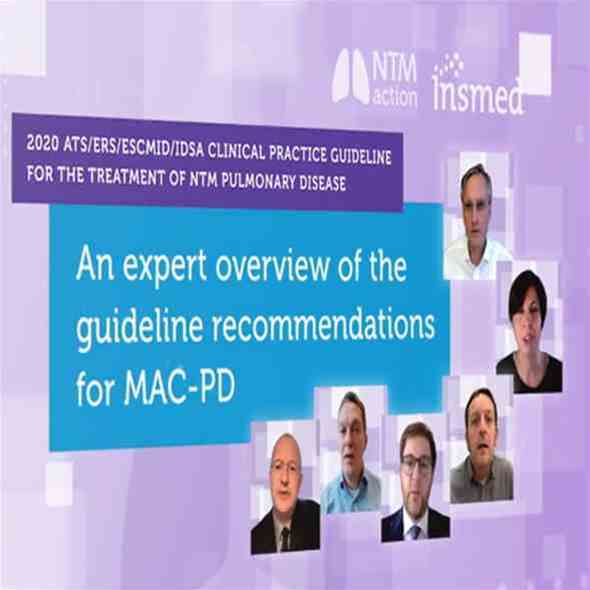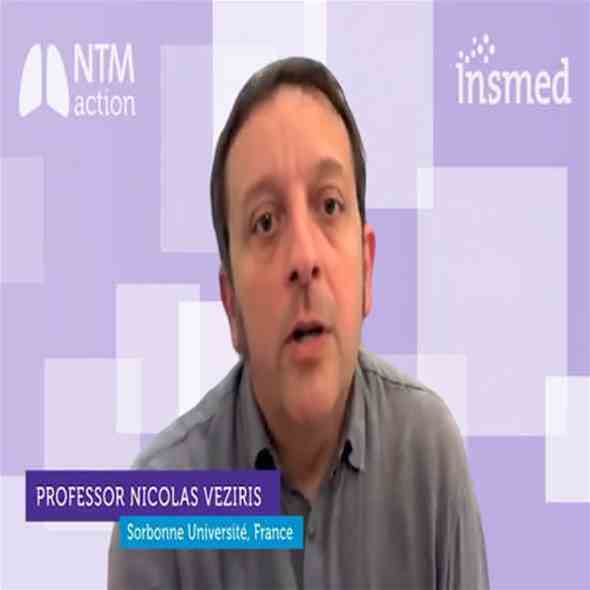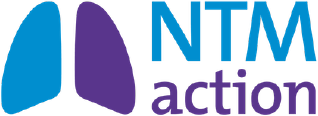Best Practice / Model of care
The management of non-tuberculous mycobacterial pulmonary disease (NTM-PD) should be a multifaceted approach, and best practice should include non-pharmacological and holistic medicine approaches to support patients in addition to appropriate pharmacological treatment regimens and monitoring
Given the complexity of NTM-PD, management should be led by a multidisciplinary team of experts and involves several steps, including patient education and counselling, non-pharmacological treatments such as airway clearance, pharmacological treatment regimens and ongoing monitoring of patients.
Patient identification
Patients must meet certain clinical, radiographical and microbiological criteria to be diagnosed with NTM-PD.1 Both clinical and radiological criteria must be met for a diagnosis as well as appropriate exclusion of other diagnoses. Microbiological criteria should include one of the following:2
- two or more positive sputum cultures
- at least one positive bronchial wash/lavage
- compatible histopathological findings with one positive culture of the same NTM species
Generally, microbiological diagnosis will require multiple morning sputum samples and tests may include:3
- acid-fast bacilli smear test
- molecular tests such as nucleic acid amplification test (NAAT)
- acid-fast bacilli culture
- antimicrobial susceptibility
Once a diagnosis of NTM-PD has been made, guidelines recommend that for particular species of NTM and circumstances you do not wait to initiate treatment. The guidelines outline which patients should be treated immediately including: patients with virulent NTM strains who are likely to experience disease progression, those with acid-fast bacilli and those with fibrocavitary disease. When untreated, Mycobacterium avium complex pulmonary disease (MAC-PD) has been shown to progress in 97.5% of patients over 6 years.4 In one study in patients with M. kansasii pulmonary disease, the prognosis was even worse, with a median survival of 71 days and an estimated 1-year mortality rate of 43%.5
Multidisciplinary teams (MDTs)
The management of NTM-PD should be overseen by an MDT with previous experience in lung disease.2 MDTs should ideally consist of the following:
- respiratory physician
- microbiologist
- specialist pharmacist
- specialist nurse
- specialist physiotherapist
- radiologist
The respiratory physician should be responsible for discussing treatment options, ongoing monitoring of the disease and optimising underlying comorbidities such as bronchiectasis. Other specialists can help in certain aspects of management including diagnosis, treatment regimens, patient education and physical interventions.
Pharmacological treatment
In patients who meet the diagnostic criteria for NTM-PD, the 2020 ATS/ERS/ESCMID/IDSA NTM-PD guidelines recommend treatment initiation rather than watchful waiting in certain patients.1 When developing a treatment regimen, the guidelines recommend considering several patient-specific factors. These include:1,6
- NTM species
- severity of disease
- risk of disease progression
- presence of comorbidity
- goals of treatment
Treatment regimens
Treatment regimens
The optimum treatment regimen varies depending on the NTM species present. Macrolide containing treatment regimens should include at least three drugs and in vitro susceptibility testing should be performed to detect potential drug resistance.1
Note: Many of the treatments in the guidelines have to be seen as "off label" as the antibiotics do not have an indication for NTM
Guideline-recommended treatment regimens for NTM-PD1
|
|
Mycobacterium avium complex |
Mycobacterium kansasii |
Mycobacterium xenopi |
Mycobacterium abscessus |
||
|
Macrolide-susceptible |
Macrolide-resistant |
Rifampicin-susceptible |
Rifampicin-resistant |
|||
|
Treatment regimen |
A macrolide (preferably azithromycin) Ethambutol Rifampicin
|
A macrolide (preferably azithromycin) Ethambutol Rifampicin Parental amikacin or streptomycin (initial therapy for 2–3 months) |
Rifampicin Ethambutol Isoniazid or a macrolide
|
Rifampicin Ethambutol Isoniazid or a macrolide Fluoroquinolone (e.g. moxifloxacin) |
Rifampicin Ethambutol A macrolide and/or a fluoroquinolone (moxifloxacin recommended)
|
Should be designed in collaboration with experts, and include at least three drugs, such as: Parental amikacin Imipenem (or cefoxitin) Tigecycline A macrolide Clofazimine Linezolid
|
|
Frequency of administration |
Daily for severe/cavitary disease or 3 times per week for nodular/bronchiectatic disease
|
Daily for severe/cavitary disease or 3 times per week for nodular/bronchiectatic disease
|
Daily |
To be determined in collaboration with experts |
||
|
Treatment duration |
At least 12 months following culture conversion |
At least 12 months in total |
At least 12 months following culture conversion |
To be determined on a case-by-case basis with expert input |
||
|
Notes |
Amikacin Liposomal Inhalation Suspension (ALIS) should be added following 6 months of failed culture conversion |
Parental amikacin and streptomycin are not recommended for routine treatment of M. kansasii PD |
Parental amikacin should be added to the regimen for cavitary or severe/bronchiectatic disease |
Macrolides should not be considered an active drug in the treatment regimen for strains with inducible or mutational macrolide resistance |
||
Surgery

Surgical resection may be appropriate for certain patients, such as those with:1
- failure of medical management
- cavitary disease
- drug-resistant isolates
- complications such as severe bronchiectasis
The decision to proceed must be weighed against the risks and benefits of surgery, and expert consultation is required.
Patient support
Once a diagnosis of NTM-PD has been made, patients and physicians need to work in partnership to help manage the disease and get the most out of treatment. Patients should be educated and supported throughout treatment and during follow-up in order to effectively manage their NTM-PD.
Psychological support
NTM-PD is a poorly understood chronic illness requiring long-term therapy that may cause or amplify negative emotions such as anxiety or depression.2,9 These may have negative consequences on medication adherence as well as quality of life (QoL). Therefore, patients may benefit from psychological interventions in order to help reduce these negative emotions.
Patients may also benefit from patient support groups such as NTM Info & Research (https://ntminfo.org/?lang=de) NTM Patient Care UK (https://www.ntmpatientcare.uk/), which aim to provide education and support for patients with NTM-PD.
Education
-
Education should be offered to patients with NTM-PD to improve understanding and self-management of NTM-PD and associated diseases such as bronchiectasis.7 Education should be tailored to each individual and may cover the following topics:
- knowledge about disease
- airway clearance techniques
- self-care techniques including optimising nutrition
- pharmacological treatment
- non-pharmacological treatment
- smoking cessation
- hospice care for those requiring end of life care
Monitoring
Monitoring
Following treatment initiation, it is important to collect clinical, radiographical and microbiological data to assess treatment response.1 Sputum cultures should be obtained every 1 to 2 months to determine treatment duration and whether culture conversion has occurred. Even in patients not receiving immediate pharmacological treatment, patients should be actively monitored for disease progression through regular sputum cultures and routine monitoring.
Side-effect monitoring
Side-effects and intolerance are common with NTM treatment regimens, so patients should be educated regarding potential side-effects and routinely monitored for adverse drug reactions.1 The frequency of monitoring adverse reactions should be decided based on the patient’s age, comorbidities, concurrent drugs, overlapping drug toxicities and resources.
Educating patients on side-effects as well as what to expect from treatment may help patients see treatment through to completion. Patients who were treated for less than 15 months after culture conversion were twice as likely to experience recurrence compared with those treated for 15 months or more.8
Non-pharmacological treatment
Patients should receive non-pharmacological treatment for other issues associated with NTM-PD in addition to treatment of the lung infection itself.9 Non-pharmacological treatment can help improve symptoms as well as health-related QoL (HRQoL).7




Psychological support
NTM-PD is a poorly understood chronic illness requiring long-term therapy that may cause or amplify negative emotions such as anxiety or depression.2,9 These may have negative consequences on medication adherence as well as quality of life (QoL). Therefore, patients may benefit from psychological interventions in order to help reduce these negative emotions.
Patients may also benefit from patient support groups such as NTM Info & Research (https://ntminfo.org) & NTM Patient Care UK (https://www.ntmpatientcare.uk), which aim to provide education and support for patients with NTM-PD.
Airway clearance
Airway clearance is an important part of NTM management and should be considered in patients with NTM-PD who have significant mucus production and clearance problems.6 Airway clearance can reduce respiratory symptoms and decline, increase sputum expectoration and improve HRQoL.7 Airway clearance techniques include:
- hypertonic saline inhalation
- active cycle of breathing techniques
- autogenic drainage
- forced expiration techniques
- manual techniques
- postural drainage
- proper hydration
- positive expiratory pressure
- oscillating positive expiratory pressure
- high-frequency chest wall oscillation
Nutrition and diet
Weight and muscle mass loss are high in patients with NTM-PD and are associated with poorer outcomes during treatment.7 For patients who are malnourished (body mass index [BMI]<20 kg/m2, serum albumin <3.5 g/dL), a diet should be introduced alongside physical activity, which aims to increase muscle strength and HRQoL, and may include:
- high-calorie intake/high protein content
- fruits and vegetables
- vitamin and mineral supplements
- oral nutritional supplements
Exercise
In patients with NTM-PD, exercise training may lead to improvements in HRQoL and exercise capacity, and reduce acute exacerbations and dyspnoea.7 Training should be individualised but may include:
- cycling
- running
- walking
- swimming
- resistance training (with hand weights or bands)
Featured content

Video
NTM: 2020 ATS, ERS, ESCMID, IDSA and NTM-PD Guidelines — an expert overview
Duration: 33 mins
Stefano Aliberti, Christoph Lange, Eva Polverino, Nicolas Veziris, Charles Haworth and Jakko van Ingen
Non-tuberculous mycobacterial pulmonary disease (NTM-PD) can be life threatening and is increasing in prevalence. International guidelines updated in 2020 provide management recommendations for the four most commonly occurring NTM pathogenic species.

Video
Duration: 5 mins
In this video European experts provide their insights into the 2020 ATS/ERS/ESCMID/IDSA guidelines on NTM-PD, with a focus on MAC-PD.

Podcast
NTM: Initiating treatment for NTM-PD - putting the patient at the heart of the matter
Duration: 4 mins
Prof Stefano Aliberti explains how and when to initiate treatment once NTM-PD has been identified
Find out more about NTM-PD
Explore which patients to treat, and when a decision to treat has been made, how to do this in line with current guideline recommendations
References:
- Daley CL et al. Eur Respir J 2020;56:1000535.
- Lipman M et al. BMJ Open Respir Res 2020;7:e000591.
- Lab Tests Online. Non-tuberculous Mycobacteria Infections. https://labtestsonline.org/conditions/nontuberculous-mycobacteria-infections [Accessed March 2021].
- Park TY et al. PLoS One 2017;12(10):e0185774.
- Liu C-J et al. Respir Med 2019;151:19–26.
- Griffith DE et al. Am J Respir Crit Care Med 2007;175:367–416.
- Lan C-C et al. J Formos Med Assoc 2020;119:S42–S50.
- Furuuchi K et al. Chest 2020;157(6):1442–5.
- Henkle E et al. Ann Am Thorac Soc 2016;13(9):S379–84.
NTM: Initiating treatment for NTM-PD - putting the patient at the heart of the matter
Thank you for registering your interest
Sorry, an error has occurred:










